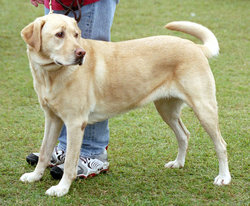 Labrador Retriever, a breed of domestic Dog
Labrador Retriever, a breed of domestic Dog
|
Dog breeds, the most complete list of dog breeds in the world |
 Labrador Retriever, a breed of domestic Dog
Labrador Retriever, a breed of domestic Dog
The Dog is a canine mammal of the Order Carnivora. Dogs were first domesticated from wolves at least 12,000 years ago[1] but perhaps as long as 150,000 years ago based on recent genetic fossil evidence and DNA evidence[2]. In this time, the Dog has developed into hundreds of breeds with a great degree of variation. For example, heights at the withers range from just a few inches (such as the Chihuahua) to roughly three feet (such as the Irish Wolfhound), and colors range from white to black, with reds, grays (usually called blue), and browns occurring in a tremendous variation of patterns. Dogs, like humans, are highly social animals and pack hunters; this similarity in their overall behavioral design accounts for their trainability, playfulness, and ability to fit into human households and social situations. Dogs fill a variety of roles in human society and are often trained as working Dogs. For Dogs that do not have traditional jobs, a wide range of Dog sports provide the opportunity to exhibit their natural skills. In many countries, the most common and perhaps most important role of Dogs is as companions. Dogs have lived with and worked with humans in so many roles that their loyalty has earned them the sobriquet "man's best friend." All dogs, are a part of the working dog world. Conversely, some cultures consider Dogs to be unclean. In other cultures, some Dogs are used as food.
Terminology
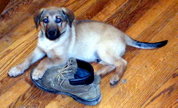 Puppies engage in
teething on almost anything.
Puppies engage in
teething on almost anything.
Dog, in common usage, refers to the domestic Dog, Canis lupus familiaris (originally classified as Canis familiaris by Linnaeus in 1758, but reclassified as a subspecies of the wolf, Canis lupus, by the Smithsonian Institution and the American Society of Mammalogists in 1993). The word is sometimes used to refer collectively to any mammal belonging to the family Canidae (as in "the Dog family"), such as wolves, foxes and coyotes.
Many additional terms are used for Dogs that are not purebred; see Terms for mixed-breed Dogs.
Physical characteristics
Although selective breeding has changed the appearance of many breeds, all Dogs retain the basic ingredients from their distant ancestors. Like most other predatory mammals, the Dog has powerful muscles, a cardiovascular system that supports both sprinting and endurance, and teeth for catching, holding, and tearing. Its skeleton provides the ability to run and leap. They have small, tight feet, and walk on their toes.
Intelligence
Among Dog lovers, Dogs are generally valued for their intelligence. Anecdotal evidence suggests that Dogs have a reasonably high intelligence. For a detailed discussion on what Dog intelligence is, see Dog intelligence.
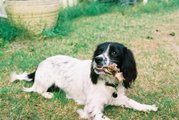 This
English Springer Spaniel is enjoying a bone.
This
English Springer Spaniel is enjoying a bone.
See also: Dog health
Presently, there is academic discussion as to whether domestic Dogs are omnivores or carnivores. The classification in the Order Carnivora does not necessarily mean that a Dog's diet must be restricted to meat. Unlike an obligate carnivore, such as a cat, a Dog is not dependent on meat protein in order to fulfill its dietary requirements. Dogs are able to healthily digest a variety of foods including vegetables and grains, and in fact can consume a large proportion of these in its diet. Wild canines not only eat available plants to obtain key amino acids, but may also obtain nutrients from vegetable matter from the stomach contents of their herbivorous prey. Domestic Dogs can survive healthily on a reasonable and carefully designed vegetarian diet, particularly if eggs and milk products are included. Some sources suggest that a Dog fed on a stict vegetarian diet may develop dilated cardiomyopathy since it lacks L-carnitine.[3]
In the wild these diets are typically pursued in the absence of available meat. It has also been noted that extremely stressful conditions, such as the Iditarod race and scientific studies of similar conditions, suggest that high-protein diets including meat help prevent damage to muscle tissue. This research is also true of other mammals.
Dogs sometimes eat grass, a harmless activity. Explanations abound, but rationales such as that it neutralizes acid are just guesses. Eating grass might make the Dog vomit, so one explanation is that Dogs eat grass to remove unwanted content from their stomachs.
Treats
Many Dogs consider anything given to them directly by hand to be a treat, even the food they are accustomed to at meal time. Such Dogs might consider anything dropped by humans, including small but indigestible objects (such as marbles, coins, rings, etc.), to be treats as well, which could be dangerous to the Dogs when ingested.
For a discussion on one use of treats in training, see clicker training.
Dangerous substances
Some foods commonly enjoyed by humans are dangerous to Dogs, including chocolate (Theobromine poisoning), onions, grapes and raisins, Macadamia nuts, and hops. Some human medications, such as acetaminophen/paracetamol (Tylenol), are highly toxic to Dogs.
Dogs also may find some poisons attractive, including antifreeze and snail bait.
Among professional breeders, Dogs are only allowed to mate for a specific purpose. Sometimes Dogs are bred to create puppies to sell, or sometimes to carry on an award-winning purebred line. Breeders who do this are usually experienced in this process. Dog breeders have access to records which allow them to accurately guess which characteristics will "breed true" in a particular Dog. Dog breeders also have accurate information on the complexities of the reproductive process for the breed of Dog that they are accustomed to handling. Dog owners may accidentally allow their pets to breed without regard to bloodlines.
Fertility
As with most domesticated species, one of the first and strongest effects seen from selective breeding is selection for cooperation with the breeding process as directed by humans. In domestic Dogs, one of the behaviours that is noted is the abolition of the pair bond seen in wild canines. The ability of female domestic Dog to come into estrus at any time of the year and usually twice a year is also valued. The amount of time between cycles varies greatly among different Dogs, but a particular Dog's cycle tends to be consistent through her life. This is also called in season or in heat. Conversely, undomesticated canine species experience estrus once a year, typically in late winter.
Menarche
Most bitches come into season for the first time between 6 and 12 months, although some larger breeds delay until as late as 2 years. Like most mammals, the age that a bitch first comes into season is mostly a function of her current body weight as a proportion of her body weight when fully mature. The different rates of maturation are responsible for the menarche, not the chronological age.
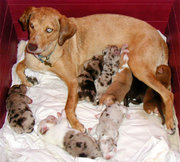 Catahoula Leopard Dog nursing litter of puppies
Catahoula Leopard Dog nursing litter of puppies
A general rule of thumb is that a mammal will produce half as many offspring as the number of teats on the mother. This rule is altered in domesticated animals since larger litters are often favoured for economic reasons. Dogs bear their litters roughly 9 weeks after fertilization. An average litter consists of about six puppies, though this number may vary widely based on the breed of Dog. Since a mother can only provide nutrients and care to a limited number of offspring, humans must assist in the care and feeding when the litter exceeds approximately eight puppies. Some breeds have been developed to emphasize certain physical traits beyond the point at which they can safely bear litters on their own. For example, the BullDog often requires artificial insemination and almost always requires cesarean section for giving birth.
Spaying or neutering refers to the removal of the male testicles or the female ovaries and uterus, in order to remove the capability to procreate, and to kill the libido.
Dog experts advise that Dogs not intended for further breeding should be spayed or neutered so that they do not have undesired puppies. Unwanted puppies are abandoned, eaten, or sometimes disposed of in an inhumane fashion. It is also common for adult stray Dogs who are placed in animal shelters to be euthanized due to lack of space and resources.
Spaying and neutering can also help prevent hormone-driven diseases such as breast cancer and prostate cancer, as well as undesired hormone-driven behaviors. The hormonal changes involved are sure to change the animal's personality somewhat, and some object to this angle as the sterilization in itself could be carried out without the excision of organs.
Contrary to myth, it is not required for a female Dog to either experience a heat cycle or have puppies before spaying, and likewise, a male Dog does not need the experience of mating before neutering; these myths are responsible for numerous unnecessary health problems and unwanted puppies. A female Dog can become pregnant on her first heat cycle (which can take place as early as six months), and should be kept away from intact male Dogs, including littermates, over the age of 4 months. Many veterinarians recommend that owners neuter/spay their pets around the age of 5 months.
Attributes
Modern Dog breeds show more variation in size, appearance, and behavior than any other domestic animal. Within the range of extremes, Dogs generally share attributes with their wild ancestors, the wolves. Dogs are predators and scavengers, possessing sharp teeth and strong jaws for attacking, holding, and tearing their food.
Sight
Dogs were thought to be dichromats and thus, by human standards, color blind.1, 2 New research is now being explored that suggests that Dogs may actually see some colour, but not to the extent that humans do. It has also been suggested that Dogs see in varieties of purple/violet and yellow shades. Because the lenses of Dogs' eyes are flatter than humans', they cannot see as much detail; on the other hand, their eyes are more sensitive to light and motion than humans' eyes. Some breeds, particularly the best sighthounds, have a field of vision up to 270? (compared to 100? to 120? for humans), although broad-headed breeds with their eyes set forward have a much narrower field of vision, as low as 180?.1, 2
Hearing
Dogs detect sounds as low as the 16 to 20 Hz frequency range (compared to 20 to 70 Hz for humans) and as high as 70,000 to 100,000 Hz (compared to 20,000 Hz for humans)2, and in addition have a degree of ear mobility that helps them to rapidly pinpoint the exact location of a sound. They can identify a sound's location much faster than a human can, and they can hear sounds up to four times the distance that humans can.
Scenting
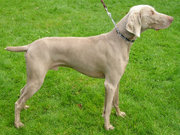 Dogs are predators suited to chasing after, leaping at, and killing
prey. (pictured:
Weimaraner)
Dogs are predators suited to chasing after, leaping at, and killing
prey. (pictured:
Weimaraner)
Dogs have nearly 220 million smell-sensitive cells over an area about the size of a pocket handkerchief (compared to 5 million over an area the size of a postage stamp for humans). Some breeds have been selectively bred for excellence in detecting scents, even compared to their canine brethren. Other than the oversimplified obvious, i.e. chemical compounds that affect chemical sensors in the nose, what a Dog actually detects when he is scenting is not really understood; although once a matter of debate, it now seems to be well established that Dogs can distinguish two different types of scents when trailing, an air scent from some person or thing that has recently passed by, as well as a ground scent that remains detectable for a much longer period. The characteristics and behavior of these two types of scent trail would seem, after some thought, to be quite different, the air scent being intermittent but perhaps less obscured by competing scents, whereas the ground scent would be relatively permanent with respect to careful and repetitive search by the Dog, but would seem to be much more contaminated with other scents. In any event, it is established by those who train tracking Dogs that it is impossible to teach the Dog how to track any better than it does naturally; the object instead is to motivate it properly, and teach it to maintain focus on a single track and ignore any others that might otherwise seem of greater interest to an untrained Dog. An intensive search for a scent, for instance searching a ship for contraband, can actually be very fatiguing for a Dog, and the Dog must be motivated to continue this hard work for a long period of time.
Direction and spatial sense
It has been observed that a lost Dog can often find its way home, sometimes traveling over long distances.
Weather detection
Dogs also have the ability to sense inclement weather (mainly thunderstorms) many miles away. This is due to their keen ability to detect fluctuations in barometric pressure and can explain a Dog's anxiety before and during a storm. The evolutionary ability of sensing weather can be traced back to when wolves used it to move the pack into proper shelter before a dangerous storm.
Dog health
Dogs are susceptible to various diseases, ailments, and poisons, some of which affect humans in the same way, others of which are unique to Dogs.
Diseases
Diseases commonly associated with Dogs include rabies (hydrophobia), canine parvovirus, and canine distemper, and pulmonic stenosis, although there are many others.
Parasites
Common external parasites are various species of fleas, ticks, and mites. Internal parasites include hookworms, tapeworms, roundworms, and heartworms.
Common physical disorders
Some breeds of Dogs are also prone to certain genetic ailments, such as hip dysplasia, luxating patellas, cleft palate, blindness, or deafness. Dogs are also susceptible to the same ailments that humans are, including diabetes, epilepsy, cancer, and arthritis. Gastric torsion and bloat is a dangerous problem in some large-chested breeds.
Behavior
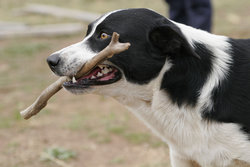 Some Dogs can be trained to retrieve
Some Dogs can be trained to retrieve
All Dogs have a tremendous capacity to learn complex social behavior and to interpret varied body language and sounds, and, like many predators, can react to and learn from novel situations. The requirements of coordinating complex social behavior requires that canines have the ability to sense and deliver a wide variety of cues via body language, more so than for even humans, who can use language for the same purpose. Physiologically, this correlates with such features as a large number of nerves innervating the facial muscles of Dogs, allowing subtle control of a wide variety of facial expressions; in contrast to cats, for instance, who have many fewer nerves governing their facial muscles, resulting in a smaller repertoire or "vocabulary" of expressions. This ability to read and deliver nonverbal cues makes Dogs expert at reading human beings, as well, often even more so than other humans are, who rely on language. Most Dog owners have a large collection of stories about their Dogs recognizing individuals by their footsteps outside the door, and so on.
Interactions between Dogs and Humans
The relationship between Dogs and humans is rooted in history and Dogs coexist with humans in a variety of ways. Dogs thrive in small social groups or packs which, from their viewpoint, can include humans. Dog society can be thought of as Dog packs characterized by a companionate hierarchy, in which each individual has a rank, and in which there is intense loyalty within the group. Dogs thrive in human society because their relationships with humans mimic their natural social patterns. The Dog is always aware of its rank relative to other individuals in the group. An assertive Dog may consider itself the alpha animal, considering its human master to be subordinate.
Dogs as working partners
Many breeds of Dogs, but not least German Shepherd, Labrador Retriever, and Border Collie are commonly used as working Dogs. There are service Dogs, guard Dogs, hunting Dogs, and herding Dogs. Dogs have served as guides for the blind, as commandos, and have flown into outer space. Most modern working Dogs are put in positions which capitalize on their sensory or strength and endurance advantages over normal humans. Dogs are also used for searching for or rescuing people and animals, such as in avalanches, at disaster sites, and for missing people or pets.
Dogs as hunting and sporting partners
Many people compete with their Dogs in a variety of Dog sports, including agility, flyball, and many others. This often strengthens the bond between human and Dog, since they must trust one another in a variety of environments and must learn how the other works and thinks.
Setters in particular have a long history as upland gun Dogs. They have a native ability to discover and "hold" upland game birds; to freeze them momentarily on the ground with their silent, elongated pointing stance. Once the hunter approaches, at his command they will flush the birds to fly and for the hunter to shoot at.
As water Dogs, the retrievers are unsurpassed. They can spend long hours in a duck blind and, after the hunter has fired at multiple ducks or geese, they can visually spot and remember the location of downed birds. At command, they dive into the icy water, swim out and retrieve the birds one by one. They can follow hand, verbal, and whistle commands at great distance as the hunter directs them to the downed bird. They typically have large, gentle muzzles to mitigate any potential damage to the game.
When trained, beagles are particularly adept at chasing through thick briars and brush after rabbits. Many hound breeds are excellent at treeing raccoons during hunting season.
Hunters with Dogs report the satisfaction that the Dogs seem to exhibit. Excitement is evident as they see the hunters load weapons, take to the field, and begin the hunt.
Dogs as pets
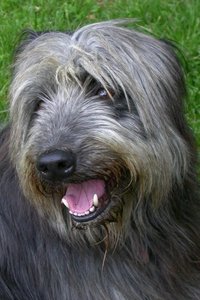 A 9 year old English
Collie
cross. Some say
mongrels make the best pets
A 9 year old English
Collie
cross. Some say
mongrels make the best pets
Relationships between humans and Dogs are often characterized by strong emotional bonds. Consequently, Dogs are popular as pets and companions, independent of any utilitarian considerations. Many Dog owners consider having unconditional acceptance from a friend who is always happy to see them to be quite utilitarian, particularly if the Dog also leads them to regular exercise. Empirically, Dogs are quite dependent on human companionship and may suffer poor health in its absence. Many Dogs are reported to have separation anxiety if their owner is away for an extended period of time.
Some research demonstrates that Dogs are able to convey a depth of emotion not seen to the same extent in any other animal; this is purportedly due to their closely-knit development with modern man, and the survival-benefits of such communication as Dogs became more dependent on humans for sustenance.
Nevertheless, it is often unwise to anthropomorphize the responses of Dogs. Despite understandably positive interpretations by Dog owners, it is questionable whether these animals are truly capable of feeling emotions on a human level. More research is needed to determine the intelligence level of Dogs, and the motivations behind their responses to their masters.
Attacks on humans and livestock
Humans have a tendency to anthropomorphize animals, particularly pets such as Dogs, which are generally portrayed as being "man's best friend". Animals are often given attributes such as "loyal", "cute", and "guardian", but these all have the potential to lure people into a false sense of security.
After thousands of years of domestication and selective breeding for Dogs whose aggression towards humans goes no further than a ferocious bark that strongly indicates dislike of a human behavior, most Dogs are unlikely to attack people. However, their sharp teeth and claws can inflict injury in an attack; a large Dog can knock a human down. Provocation can range from something as seemingly innocuous as a toddler pulling a Dog's tail, in which case the Dog might nip to discourage the behavior, to something completely transparent to humans, such as an odor or a movement that sets a Dog off, to blatant human aggression or violence towards a Dog, causing it to defend itself. There are hundreds of shades of provocation that may or may not lead to an attack upon a human. Canine aggression upon humans is ordinarily not tolerated, but any human aggression against an animal having formidable means of self-defense is foolhardy in the extreme.
With formidable skills and weapons as hunters as well as large and unfussy appetites, Dogs often menace livestock and wildlife. In most jurisdictions, Dogs are destroyed for killing other creatures, so Dogs should be prevented from any encounter with livestock or wildlife that might lead to a predatory response. The same creatures that wolves, coyotes, and foxes attack as prey, especially sheep and poultry, are similarly attractive prey to Dogs.
Abandoned Dogs
Wild Dogs are shot by farmers in an effort to protect livestock. Bodies are sometimes tied to fences as warning to other Dogs, especially in rural United States and Canada. Abandoned domestic Dogs who become feral are particularly dangerous; they lack the survival skills of wild canines, as well as the genetic and learned fear of the humans' world. Feral Dogs often form predatory packs that attack livestock and occasionally also prove dangerous to humans.
In the UK, it is illegal to kill Dogs, even if they are on your private land; you are required to contact your local Police Force, DogsTrust, or the local branch of the RSPCA, who will arrange its collection.
Ancestry and history of domestication
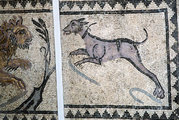 This ancient mosaic, likely Roman, shows a large Dog with a collar
hunting a lion.
This ancient mosaic, likely Roman, shows a large Dog with a collar
hunting a lion.
Molecular systematics indicate that the domestic Dog (Canis lupus familiaris) descends from one or more populations of wild wolves (Canis lupus). As reflected in the nomenclature, Dogs are a subspecies of wolf and are thus still able to interbreed.
The relationship between man and canine has deep roots. Wolf remains have been found in association with hominid remains dating from 400,000 years ago. Converging archaeological and genetic evidence indicate a time of domestication in the late Upper Paleolithic close to the Pleistocene/Holocene boundary, between 17,000 and 14,000 years ago. Fossil bone morphologies and genetic analysis of current and ancient Dog and wolf populations have not yet been able to conclusively determine whether all Dogs descend from a single domestication event, or whether Dogs were domesticated independently in more than one location. Domesticated Dogs may have interbred with local populations of wild wolves on several occasions (so-called introgression).
The earliest Dog fossils, two crania from Russia and a mandible from Germany, date from 13,000 to 17,000 years ago. Their likely ancestor is the large northern Holarctic wolf, Canis lupus lupus. Remains of smaller Dogs from Mesolithic (Natufian) cave deposits in the Middle East, dated to around 12,000 years ago, have been interpreted as descendants of a lighter Southeest Asian wolf, Canis lupus arabs. Rock art and skeletal remains indicate that by 14,000 years ago, Dogs were present from North Africa across Eurasia to North America. Dog burials at the Mesolithic cemetery of Svaerdborg in Denmark suggest that in ancient Europe Dogs were valued companions.
Genetic analyses have so far yielded divergent results. Vil?, Savolainen, and colleagues (1997) concluded that Dogs split off from wolves between 75,000 and 135,000 years ago, while a subsequent analysis by Savolainen et al. (2002) indicated a "common origin from a single gene pool for all Dog populations" between 40,000 and 15,000 years ago in East Asia. Verginelli et al. (2005), however, suggest both sets of dates must be reevaluated in light of recent findings showing that poorly calibrated molecular clocks have systematically overestimated the age of geologically recent events. On balance, and in agreement with the archaeological evidence, 15,000 years ago is the most likely time for the wolf-Dog divergence.
Verginelli examined ancient DNA evidence from five prehistoric Italian canids carbon-dated to between 15,000 and 3,000 years old, 341 wolves from several populations worldwide, and 547 purebred Dogs. Their results indicate multiple independent origins of Dogs and/or of frequent interbreeding between early proto-Dogs and wolves throughout a vast geographic range. The detailed history remains unexplored and until further evidence is available, the following section on wolf ancestors must be considered purely speculative.
Wolf ancestors
Although all wolves belong to the species Canis lupus, there are (or were) many subspecies that had developed a distinctive appearance, social structure, and other traits. For example, the Japanese wolf and the Eastern Timber Wolf posses different distinctive colouration, hunting and social structures.
The Indian Wolf is thought to have contributed to the development of more breeds of Dogs than other subspecies. Many of today's wild Dogs, such as the dingo, the dhole and pariah Dogs, are descended from this wolf.
The Indian wolf is also thought to have bred with descendants of the European wolf to create the Mastiffs and eventually leading to the development of such diverse breeds as the Pug, the Saint Bernard, and the Bloodhound. The Tibetan Mastiff is an example of an ancient breed.
The European wolf, in turn, may have contributed many of its attributes to the Spitz Dog types, most terriers, and many of today's sheepDogs. The Chinese wolf is probably ancestor to the Pekingese and toy spaniels, although it is also probable that descendants of the Chinese and European wolves encountered each other over the millennia, contributing to many of the oriental toy breeds.
The Eastern Timber Wolf is a direct ancestor to most, if not all, of the North American northern sled Dog types. This interbreeding still occurs with Dogs living in the Arctic region, where the attributes of the wolf that enable survival in a hostile environment are valued by humans. Additionally, unintentional crossbreeding occurs simply because Dogs and wolves live in the same environment. The general reproductive isolation which is required to define Dogs and wolves as separate species is purely a result of lack of opportunity, stemming from a general mutual unfamiliarity, suspicion, mistrust, and fear.
The phenotypic characteristic that distinguish a wolf from a Dog are tenuous. Wolves typically have a "brush tail" and erect ears. While some Dog breeds possess one of these characteristics, they rarely possess both.
Speed of domestication
Current research indicates that domestication, or the attributes of a domesticated animal, can occur much more quickly than previously believed. Domestication of a wild Dog may occur within one or two human generations with deliberate selective breeding. It is also now generally believed that initial domestication was not attained solely by human desire intervention but through mutual desire. Wild canines who scavenged around human habitations received more food than their more skittish or fearful counterparts. Canines who attacked people or their children were likely killed or driven away, while those more friendly animals survived. Canines would have been beneficial by chasing away other vermin or scavengers. With their sharp senses, they would also be valuable as an alarm against marauding predators. The relationship is theorized to have developed in this way.
Dog breedsThere are numerous Dog breeds, over 800 being recognized by various kennel clubs worldwide. As all Dog breeds have been derived from mixed-breed Dog populations, the term "purebred" has meaning only with respect to a certain number of generations. Many Dogs, especially outside the United States and Western Europe, belong to no recognized breed.
A few basic breed types have evolved gradually during the domesticated Dog's relationship with man over the last 10,000 or more years, but most modern breeds are of relatively recent derivation. Many of these are the product of a deliberate process of artificial selection. Because of this, some breeds are highly specialized, and there is extraordinary morphological diversity across different breeds. Despite these differences, Dogs are able to distinguish Dogs from other kinds of animal.
The definition of a Dog breed is a matter of some controversy. Some groups use a definition that ultimately requires extreme inbreeding to qualify due to the low gene pool. Dogs that are bred in this manner often end up with severe health or behavioural problems. Other organizations define a breed more loosely, such that an individual may be considered of one breed as long as 75% of its parentage is of that breed. These considerations come into play among breeders who enter their Dogs in Dog shows. Even prize-winning purebred Dogs sometimes possess crippling genetic defects due to inbreeding. These problems are not limited to purebred Dogs and can affect mixed-breed populations. The behavior and appearance of a Dog of a particular breed can be predicted fairly accurately, while mixed-breed Dogs show a broader range of innovative appearance and behavior.
In February 2004, the Canine Studies Institute in Aurora, Ohio, arranged recognized breeds of Dogs into ten categories.
Mixed-breed Dogs or Mongrels are Dogs that do not belong to specific breeds, being mixtures of two or more in variant percentages. Mixed breeds, or Dogs with no purebred ancestry, are not inherently "better" or "worse" than purebred Dogs as companions, pets, working Dogs, or competitors in Dog sports. Sometimes mixed-breed Dogs are deliberately bred, for example, the Cockapoo, a mixture of Cocker Spaniel and Miniature Poodle. Such deliberate crosses may display hybrid vigor and other desirable traits, but can also lack one or more of the desired traits of their parents, such as temperament or a particular color or coat. However, without genetic testing of the parents, the crosses can sometimes end up inheriting genetic defects that occur in both parental breeds. Deliberately crossing two or more breeds is also a manner of establishing new breeds.
Neoteny in the rapid evolution of diverse Dog breeds
This rapid evolution of Dogs from wolves is an example of neoteny or paedomorphism. As with many species, the young wolves are more social and less dominant than adults; therefore, the selection for these characteristics, whether deliberate or inadvertent, is more likely to result in a simple retention of juvenile characteristics into adulthood than to generate a complex of independent new changes in behavior. This is true of many domesticated animals, including human beings themselves, who have many characteristics similar to young bonobo. This paedomorphic selection naturally results in a retention of juvenile physical characteristics as well. Compared to wolves, many adult Dog breeds retain such juvenile characteristics as soft fuzzy fur, round torsos, large heads and eyes, ears that hang down rather than stand erect, etc.; characteristics which are shared by most juvenile mammals, and therefore generally elicit some degree of protective and nurturing behavior cross-species from most adult mammals, including humans, who term such characteristics "cute" or "appealing".
The example of canine neoteny goes even further, in that the various breeds are differently neotenized according to the type of behavior that was selected.
Of course, Dogs in general possess a significant ability to modify their behavior according to experience, including adapting to the behavior of their "pack leaders"?again, humans. This allows them to be trained to behave in a way that is not specifically the most natural to their breed; nevertheless, the accumulated experience of thousands of years shows that some combinations of nature and nurture are quite daunting, for instance, training whippets to guard flocks of sheep.
See also
References and further reading
"Multiple and Ancient Origins of the Domestic Dog")
External links
Dog, canine mammal, Order Carnivora,Dogsdomesticated,wolves12,000 years ago, breed, breeders, training, picture, grooming, supply, food, kennel